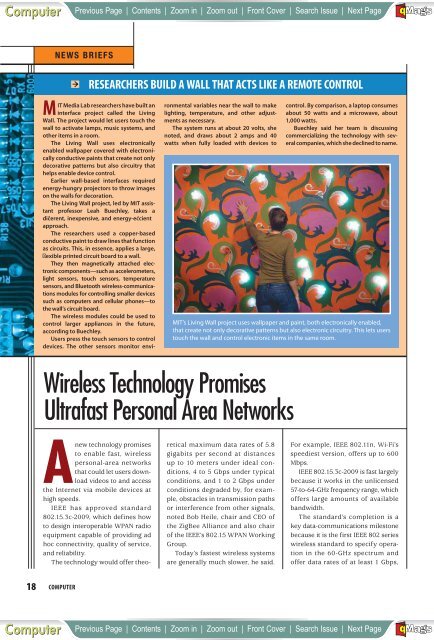computing lives - FTP Directory Listing
computing lives - FTP Directory Listing
computing lives - FTP Directory Listing
Create successful ePaper yourself
Turn your PDF publications into a flip-book with our unique Google optimized e-Paper software.
A<br />
Computer Previous Page | Contents | Zoom in | Zoom out | Front Cover | Search Issue | Next Page M S BE<br />
aG<br />
F<br />
18<br />
NEWS BRIEFS<br />
MIT Media Lab researchers have built an<br />
interface project called the Living<br />
Wall. The project would let users touch the<br />
wall to activate lamps, music systems, and<br />
other items in a room.<br />
The Living Wall uses electronically<br />
enabled wallpaper covered with electronically<br />
conductive paints that create not only<br />
decorative patterns but also circuitry that<br />
helps enable device control.<br />
Earlier wall-based interfaces required<br />
energy-hungry projectors to throw images<br />
on the walls for decoration.<br />
The Living Wall project, led by MIT assistant<br />
professor Leah Buechley, takes a<br />
dičerent, inexpensive, and energy-ećcient<br />
approach.<br />
The researchers used a copper-based<br />
conductive paint to draw lines that function<br />
as circuits. This, in essence, applies a large,<br />
exible printed circuit board to a wall.<br />
They then magnetically attached electronic<br />
components—such as accelerometers,<br />
light sensors, touch sensors, temperature<br />
sensors, and Bluetooth wireless-communications<br />
modules for controlling smaller devices<br />
such as computers and cellular phones—to<br />
the wall’s circuit board.<br />
The wireless modules could be used to<br />
control larger appliances in the future,<br />
according to Buechley.<br />
Users press the touch sensors to control<br />
devices. The other sensors monitor envi-<br />
Anew technology promises<br />
to enable fast, wireless<br />
personal-area networks<br />
that could let users download<br />
videos to and access<br />
the Internet via mobile devices at<br />
high speeds.<br />
IEEE has approved standard<br />
802.15.3c-2009, which defines how<br />
to design interoperable WPAN radio<br />
equipment capable of providing ad<br />
hoc connectivity, quality of service,<br />
and reliability.<br />
The technology would offer theo-<br />
COMPUTER<br />
RESEARCHERS BUILD A WALL THAT ACTS LIKE A REMOTE CONTROL<br />
ronmental variables near the wall to make<br />
lighting, temperature, and other adjustments<br />
as necessary.<br />
The system runs at about 20 volts, she<br />
noted, and draws about 2 amps and 40<br />
watts when fully loaded with devices to<br />
retical maximum data rates of 5.8<br />
gigabits per second at distances<br />
up to 10 meters under ideal conditions,<br />
4 to 5 Gbps under typical<br />
conditions, and 1 to 2 Gbps under<br />
conditions degraded by, for example,<br />
obstacles in transmission paths<br />
or interference from other signals,<br />
noted Bob Heile, chair and CEO of<br />
the ZigBee Alliance and also chair<br />
of the IEEE’s 802.15 WPAN Working<br />
Group.<br />
Today’s fastest wireless systems<br />
are generally much slower, he said.<br />
control. By comparison, a laptop consumes<br />
about 50 watts and a microwave, about<br />
1,000 watts.<br />
Buechley said her team is discussing<br />
commercializing the technology with several<br />
companies, which she declined to name.<br />
MIT’s Living Wall project uses wallpaper and paint, both electronically enabled,<br />
that create not only decorative patterns but also electronic circuitry. This lets users<br />
touch the wall and control electronic items in the same room.<br />
Wireless Technology Promises<br />
Ultrafast Personal Area Networks<br />
For example, IEEE 802.11n, Wi-Fi’s<br />
speediest version, offers up to 600<br />
Mbps.<br />
IEEE 802.15.3c-2009 is fast largely<br />
because it works in the unlicensed<br />
57-to-64-GHz frequency range, which<br />
offers large amounts of available<br />
bandwidth.<br />
The standard’s completion is a<br />
key data-communications milestone<br />
because it is the first IEEE 802 series<br />
wireless standard to specify operation<br />
in the 60-GHz spectrum and<br />
offer data rates of at least 1 Gbps,<br />
A<br />
Computer Previous Page | Contents | Zoom in | Zoom out | Front Cover | Search Issue | Next Page M S BE<br />
aG<br />
F

















